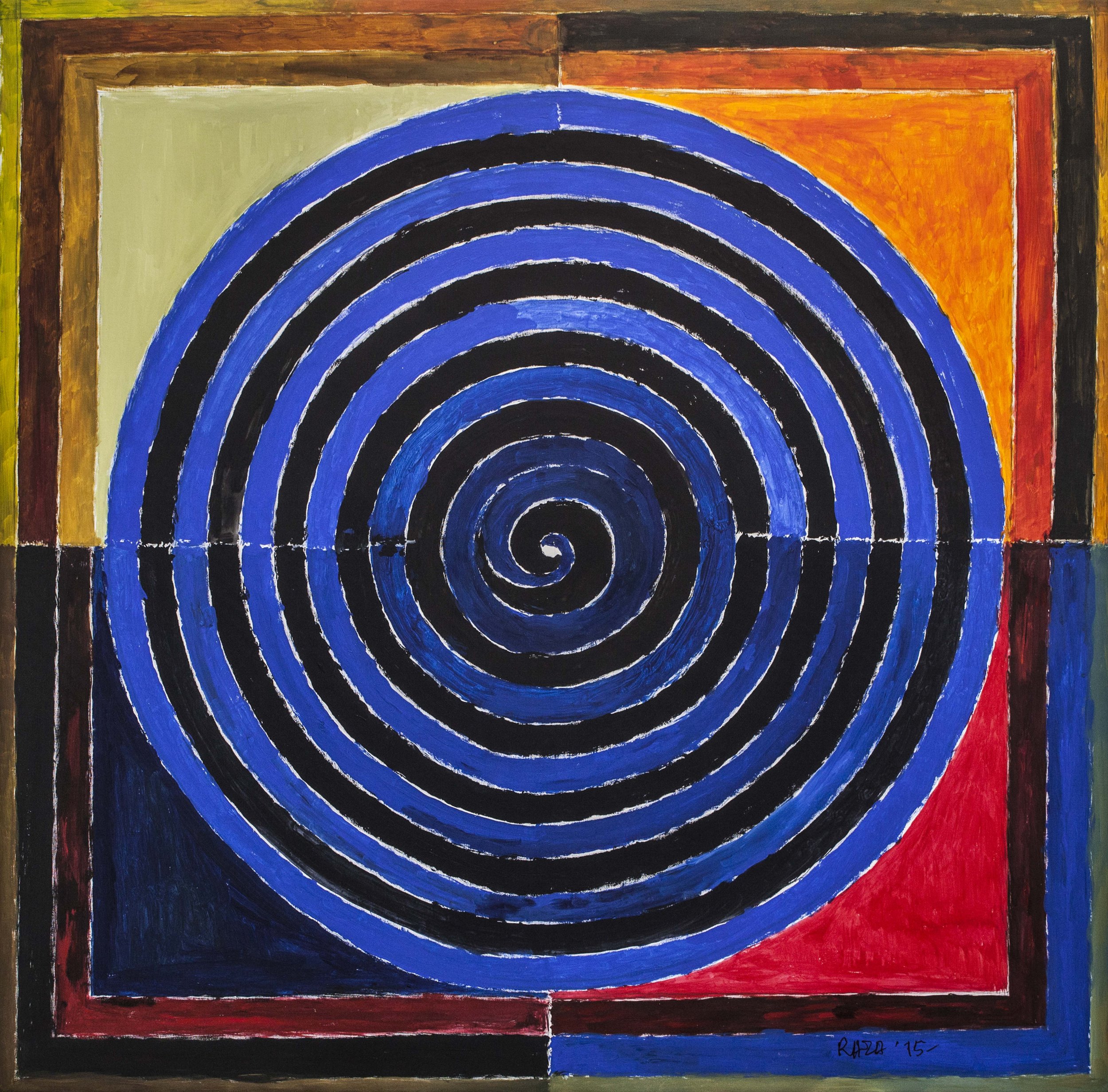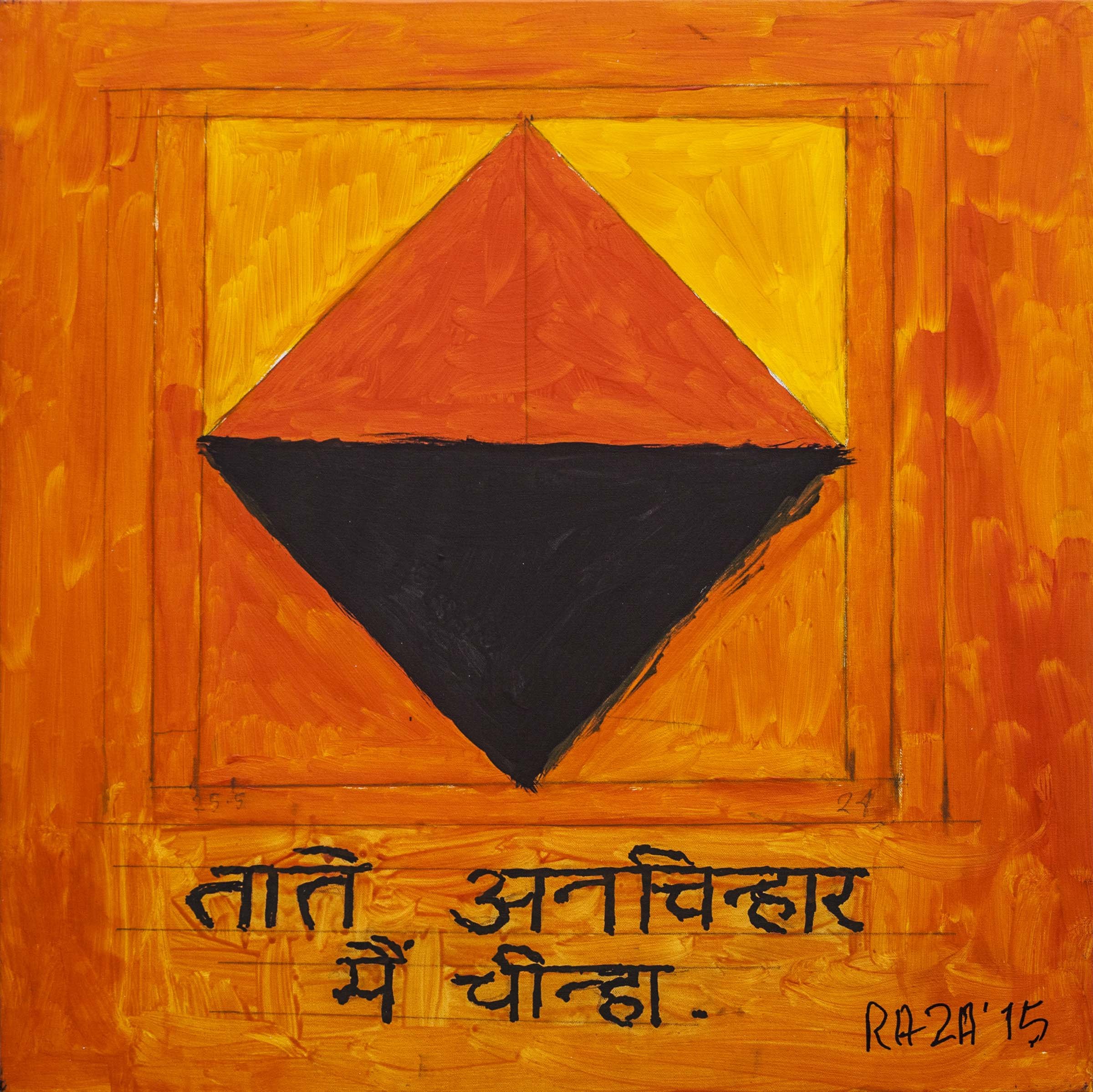
Dance of The Elements by S H Raza
February 19 – March 21, 2021 at Akar Prakar, Delhi
The five elements dance through the late phase of S. H. Raza’s work, crossing the distance between emptiness and plenitude, restlessness and repose. They appear as themselves, symbolically rendered, as the Pancha-Tatva. In an incandescent exchange of attributes, they also appear as one another.
Fire ripples like a river through some of Raza’s paintings of the second decade of the 21st century. In other paintings from this period, earth seems buoyant as air, while ether, invisible yet palpable, attunes all things and symbols to its shimmering aura. In crossing one element with another, Raza also invited us to experience the world through a crossing of the senses: synaesthesia, when a sensation addressed to one sense is registered by another. In Raza’s late paintings, colour comes through as sound, line as the memory of touch.
In the same spirit, we respond to the subtle interplay of visuality and language in Raza’s art, the symbiosis of image and text. Every now and again, a floating line from a poem, chant or scripture found habitation in one of his paintings. Sometimes, an entire text. As we gaze upon it, the text variously animates or illuminates the image, or holds it in dialogue or counterpoint. It gathers the energy of a mantra. Consider a painting that is vibrant with glowing reds, suggestive of the earth blazing in summer, fields of red chillies drying in the sun. Across its lower edge runs a line from Amir Khusro’s poetry: Badi kathin hai dagar panghat ki. It’s tricky, the path to the ghat where water awaits. A village topography is invoked: narrow track, grass, stone ghats, river. Through the simplest yet most sensuously rich means, we are pointed towards the arduous yet ardent quest for spiritual bliss.
We are drawn to the sonic dimension in Raza’s late work: the articulation of light as sound, the universe manifesting its presence as beat and cadence. Aalok, rendered as a concentric array of circles radiating outwards from a central source, is both radiance and resonance. Laya is a concentric array elaborated into an Orphist kaleidoscope of scintillating colour units, intuitively pointing us towards the circling and gathering patterns of dance.
In an epoch of displacement and migration, many of us are homeless under the sky. How do we find our way back to the consolation that Raza’s Neelambar offers, the blue mantle of the cosmos? In Raza’s late paintings, insistently, we find ourselves returned to the point of origin, Aarambh, and the process of descending into the world, Avtaran. What he celebrated in his paintings was the leela, the play, through which the One presented itself as the Many. Each of the Many was a valid and exquisite dimension of the One. Appearance, to the idealist philosopher, is a veil, a phantom, an ephemeral illusion. To the painter, appearance – however momentary and finite – is the most tangible token of infinity, the flower that speaks of the forest.
Ranjit Hoskote
SH Raza | Avtaran | Acrylic on canvas | 24 x 12 in | 2014
SH Raza | Jeevan | Acrylic on canvas | 47 x 16 in | 2015
SH Raza | Kundalini | Acrylic on canvas | 40 x 40 in | 2015
SH Raza | Neelambar | Acrylic on Canvas | 24 x 24 in | 2015
SH Raza | Panch Tatva 3 | Acrylic on canvas | 24 x 24 in | 2016
SH Raza | Beej Vriksha 2 | Acrylic on canvas | 32 x 16 in | 2013
SH Raza | Untitled | Acrylic on paper (tryptich) | 25.5 x 23.5 in | 2010
SH Raza | Vriksha | Acrylic on canvas | 16 x 16 in | 2013
SH Raza | Vinyas | Acrylic on canvas | 20 x 20 in | 2015
SH Raza | Srijan | Acrylic on canvas | 24 x 24 in | 2016
SH Raza | Panch Tatva 2 | Acrylic on canvas | 24 x 24 in | 2015
SH Raza | Aalok | Acrylic on canvas | 47 x 47 in | 2013
SH Raza | Aavarta | Acrylic on canvas | 16 x 16 in | 2014
SH Raza | Akar Prakar | Acrylic on canvas | 40 x 40 inch | 2015
SH Raza | Bindu Shrinkhala | Acrylic on canvas | 16 x 16 in | 2014
SH Raza | Chaturdik | Acrylic on canvas | 24 x 24 in | 2014
SH Raza | Kendra | Acrylic on canvas | 24 x 24 in | 2014
SH Raza | Laya | Acrylic on canvas | 16 x 16 in | 2014
SH Raza | Vividha | Acrylic on canvas | 24 x 12 in | 2015
SH Raza | Tree of Life | Acrylic on Canvas | 24 x 12 in | 2015
SH Raza | Roopakar | Acrylic on canvas | 16 x 16 in | 2015
SH Raza | Taa te | Acrylic on canvas | 16 x 16 in | 2015
SH Raza | Thoughts of Gandhi ji | Acrylic on canvas | 60 x 47 in | 2013
SH Raza | Swadharm | Acrylic on canvas | 47 x 47 in | 2013
SH Raza | Untitled | Pastel on canvas | 12 x 12 in | 2011
SH Raza | Shabd Bindu | Pen and ink on paper | 16 x 12 in | 2011
SH Raza | Untitled | Pen and ink on paper | 12 x 16 in | 2011
SH Raza | Untitled | Pen and ink on paper | 12 x 16 in | 2011
SH Raza | Untitled | Pen and ink on paper | 12 x 16 in | 2011
SH Raza | Untitled | Pen and ink on paper | 12 x 16 in | 2011
SH Raza | Untitled | Pen and ink on paper | 12 x 16 in | 2011
SH Raza | Untitled | Pen and ink on paper | 12 x 16 in | 2011
About S H Raza
Sayed Haider Raza (22nd February 1922- 23rd July 2016):
Sayed Haider Raza was born in 1922 in Madhya Pradesh and studied painting at the Nagpur School of Art and the Sir J.J.School of Art. After receiving a French government scholarship in 1950 he left for Ecole Nationale des Beaux Arts, Paris. Raza was awarded the Prix de la Critique in Paris in 1956. In 1962 he served as a visiting lecturer at the University of California in Berkeley, USA. Raza was one of the founders of the Progressive Artists’ Group, along with K.H. Ara and F.N. Souza. He has participated in numerous exhibitions, including the Sao Paulo Biennale in 1958, the Biennale de Menton, in France in 1966, 1968 and in 1978, and Contemporary Indian Painting, at the Royal Academy in London, in 1982.
In December 1978 the Madhya Pradesh Government invited him to his native state for homage and an exhibition of his work in Bhopal. He was elected Fellow of the Lalit Kala Akademi in 1983. In 1997 Raza was awarded the Madhya Pradesh Government’s prestigious Kalidas Samman.
He was conferred the Padma Shree Award by the President of India in 1981, the Padma Bhushan in 2007 and Padma Vibhushan in 2013.
He passed away on July, 2016 in Delhi.



































